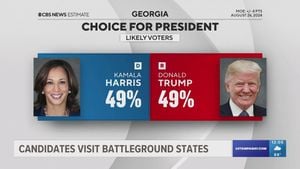With the 2024 presidential election just around the corner, the race is heating up as candidates present their visions for the future of higher education and student loan policies. On one side, Vice President Kamala Harris, paired with Minnesota Governor Tim Walz, pledges to uphold and build upon the initiatives established by President Biden. On the other hand, former President Donald Trump, alongside potential running mate JD Vance, offers contrasting approaches, signaling possible cuts to federal education funding and reformative measures focused on school vouchers. The stakes are high for the millions of borrowers across the nation, particularly when 22% of student loan borrowers state student loan forgiveness as one of their top voting issues. A recent survey reveals the divergence of views on education policy is poised to influence voter decisions, with 43% of Democrats and 30% of Republicans stating student loan repayments will impact their choices at the polls.
Harris’s vision for education extends from her time as Attorney General of California, where she took decisive actions against predatory for-profit colleges like Corinthian Colleges, successfully winning a substantial $1.1 billion judgment against it. Under the Biden administration, Harris has been part of efforts to cancel over $168 billion of student debt for approximately 4.76 million borrowers. This commitment to aiding borrowers reflects her position against the alarming rise of student loans, ensuring they're equipped with the necessary consumer protections. Currently, the legal battle surrounding Biden’s proposed sweeping debt forgiveness continues, but Harris is poised to vigorously defend such efforts should she take office.
Meanwhile, Trump's education policy appears shaped significantly by his document, Project 2025—a plan advocating for various reforms including the removal of the Department of Education. Critics argue these proposed changes could hinder educational access and funding for disadvantaged groups, particularly impacting low-income families and students of color. Trump calls for the implementation of private school vouchers, which may align well with Ohio’s current policies but diverges sharply from Harris’s stance, who opposes any such move, viewing it as detrimental to public education.
Delving deep, the stark contrasts become clearer. Harris promotes increased funding for public education and the continual support of both federally recognized Historically Black Colleges and Universities (HBCUs) and childcare programs like Head Start, claiming pivotal roles for preparing children for school. Conversely, Trump's strategy indicates slashing both funding for federal education programs and moving to eliminate substantial educational structures, presenting risks to low-income students’ futures across the nation. The potential ramifications of this legislation underpins the urgency for voters to investigate how their choice may influence the accessibility and quality of education for generations to come.
Harris’s ticket emphasizes public school investment exceeding beyond mere policy. Her history, alongside Walz’s perspective as a former public educator, positions them as favorable advocates for both raising teacher salaries—currently hovering around $66,390 median yearly pay—and improving educational outcomes for public schools. Contrarily, Trump’s commitment remains targeted at promoting private sector involvement, potentially benefitting for-profit education systems over conventional public institutions. The idea of making higher education more affordable through vocational training and community colleges showcases Trump’s inclination to redefine the educational pathway, though the feasibility and efficiency of such alternatives remains heavily debated.
On the issue of income-driven repayment plans, Harris backs existing frameworks like the recently introduced SAVE plan, which aligns monthly payments according to income, with suggestions of forgiveness for long-standing borrowers. Trump, anticipated to favor more stringent measures, plans to potentially dissolve SAVE and pivot toward creating regulations which could lead to less consumer-favoring alternatives, including raising monthly payments for borrowers significantly. The apparent shift poses considerable challenges for families focusing on student debt relief.
Student loan forgiveness remains perhaps the most contentious element on the agenda. The Biden administration explored extensive debt relief strategies, yet many fear Trump’s inclination to roll back such policies could revert progress made, leaving borrowers vulnerable to their overwhelming balances. This pushback from the Trump camp also hints at renegotiations surrounding expanded access to educational opportunities, dropping dependence on public options which Harris staunchly supports. Harris seeks to protect the Department of Education, thereby ensuring adherence to civil rights laws and consolidations from problematic past measures against marginalized groups, including LGBTQ+ students. The possibility of overturning policies aimed at protecting these student rights under Trump amplifies concerns for those relying on federal guidance during their pursuits for education.
Beyond student debt, accreditation and institutional credibility remain pivotal topics, especially as candidates outline their strategies for structural reforms. Trump’s aggressive stance implies dramatic overhauls, targeting accreditors perceived as inequitable for what he brands as ‘Marxist ideologies’ infiltrated within campuses. Harris, exhibiting historical scrutiny over questionable accreditation practices, plans to enforce stringent regulations ensuring colleges operate with transparency, emphasizing accountability and proper student support.
This mix of polices brings to light the political machinery eager to influence higher education across America. When asking constituents from diverse backgrounds about their thoughts on who may best serve their needs, one thing resonates: accessibility to education must be protected and prioritized. The divide between Republicans and Democrats sheds brightness on how the leadership approach bears on student investments, curricular decisions, and the trickle-down effect on future employment prospects. An election year like this one heightens the necessity for voters to inform themselves on the candidates’ domestic education policies to speak for their future effectively.



